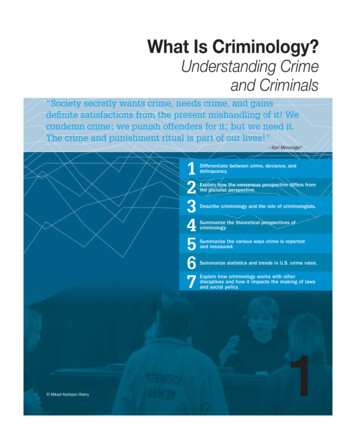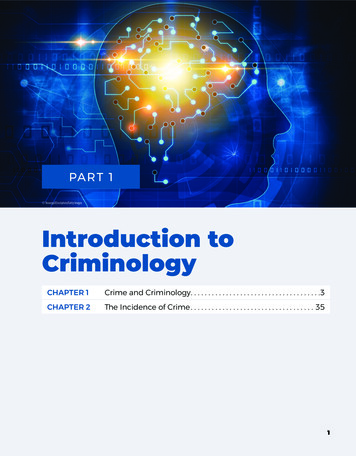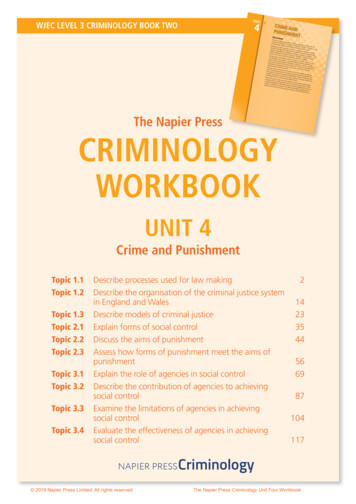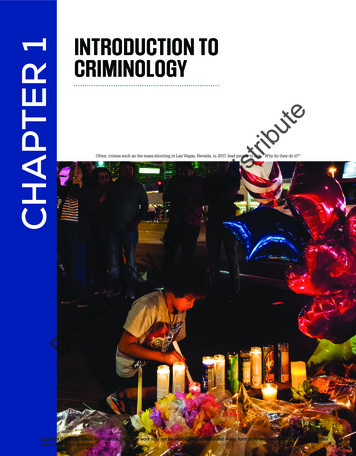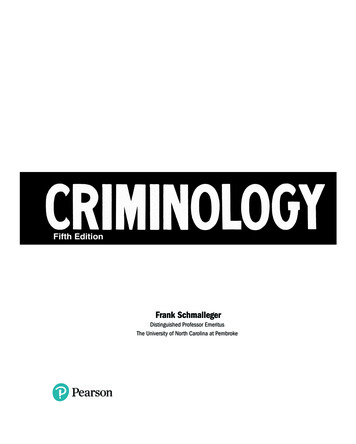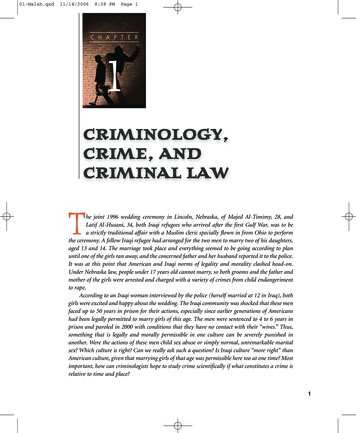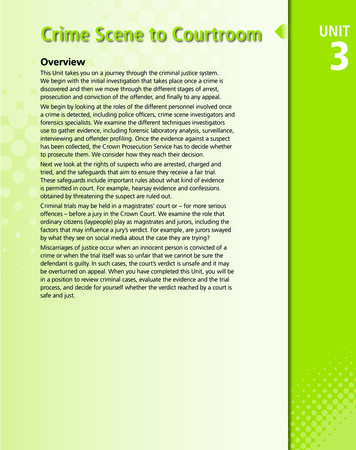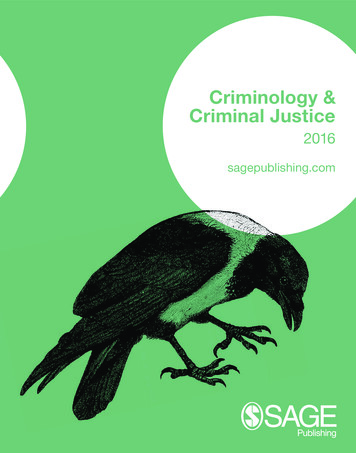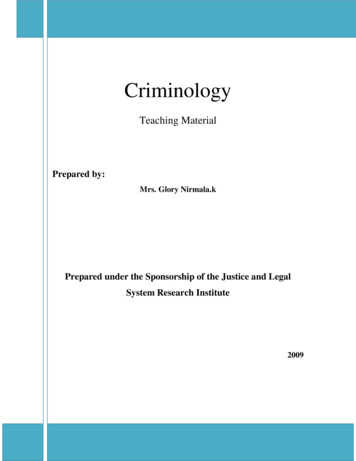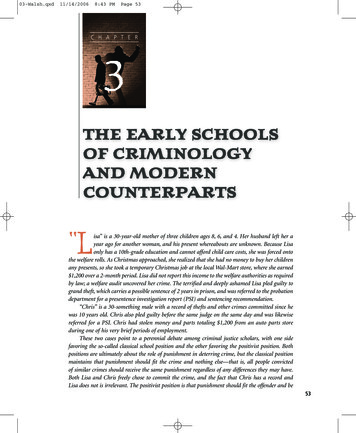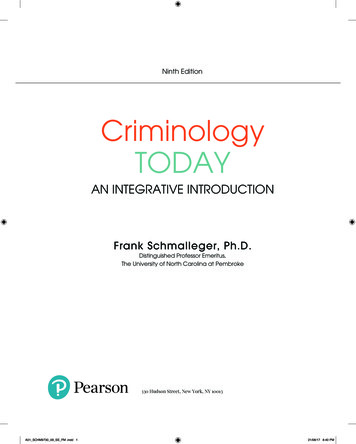
Transcription
Ninth EditionCriminologyTODAYAN INTEGRATIVE INTRODUCTIONFrank Schmalleger, Ph.D.Distinguished Professor Emeritus,The University of North Carolina at Pembroke330 Hudson Street, New York, NY 10013A01 SCHM9730 09 SE FM .indd 121/08/17 8:40 PM
For my daughter Nicole,a next-generation criminologist.Vice President, Portfolio Management: Andrew GilfillanPortfolio Manager: Gary BauerEditorial Assistant: Lynda CramerSenior Vice President, Marketing: David GesellField Marketing Manager: Bob NisbetDirector, Digital Studio and Content Production: Brian HylandManaging Producer: Cynthia ZonneveldContent Producer: Holly ShufeldtManager, Rights Management: Johanna BurkeOperations Specialist: Deidra SmithCreative Digital Lead: Mary SienerManaging Producer, Digital Studio: Autumn BensonContent Producer, Digital Studio: Maura BarclayFull-Service Management and Composition: Integra Software Services, Ltd.Full-Service Project Manager: Abinaya RajendranCover Design: Studio MontageCover Photo: A Lesik/Shutterstock; Gwoeii/Shutterstock; DatskevichAleh/Shutterstock; TSpider/Shutterstock; Manley099/E /Getty Images;CribbVisuals/E /Getty ImagesPrinter/Binder: LSC Communications, Inc.Cover Printer: Phoenix Color/HagerstownText Font: Bembo MT Pro 10/13Credits and acknowledgments for content borrowed from other sources and reproduced, with permission, in this textbook appear on the appropriate page within the text.Acknowledgements of third party content appear on page with the borrowed material, which constitutes an extension of this copyright page.Unless otherwise indicated herein, any third-party trademarks that may appear in this work are the property of their respective owners and any references tothird-party trademarks, logos or other trade dress are for demonstrative or descriptive purposes only. Such references are not intended to imply any sponsorship,endorsement, authorization, or promotion of Pearson’s products by the owners of such marks, or any relationship between the owner and Pearson Education, Inc.or its affiliates, authors, licensees or distributors.The Internet addresses listed in the text were accurate at the time of publication. The inclusion of a website does not indicate an endorsement by the author orPearson Education. Pearson Education does not guarantee the accuracy of the information presented at these sites.Copyright 2019, 2017, 2015, 2012, 2009 by Pearson Education, Inc. or its affiliates. All Rights Reserved. Printed in the United States of America. Thispublication is protected by copyright, and permission should be obtained from the publisher prior to any prohibited reproduction, storage in a retrieval system, ortransmission in any form or by any means, electronic, mechanical, photocopying, recording, or otherwise. For information regarding permissions, request forms andthe appropriate contacts within the Pearson Education Global Rights & Permissions department, please visit www.pearsoned.com/permissions/.Many of the designations by manufacturers and sellers to distinguish their products are claimed as trademarks. Where those designations appear in this book, and thepublisher was aware of a trademark claim, the designations have been printed in initial caps or all caps.Library of Congress Cataloging-in-Publication DataSchmalleger, Frank, author.Criminology today: an integrative introduction / Frank Schmalleger, Ph.D., DistinguishedProfessor Emeritus, The University of North Carolina at Pembroke.Ninth Edition. Hoboken: Pearson, [2019] Revised edition of the author’s Criminology today, [2017] Includes bibliographical references and indexes.LCCN 2017020526 ISBN 9780134749730 (alk. paper) ISBN 0134749731 (alk. paper) ISBN 9780134146386 (perfect bound) ISBN 0134146387 ISBN 9780134417110 (loose leaf) ISBN 0134417119 (loose leaf)Subjects: LCSH: Criminology. Criminology—United States.LCC HV6025 .S346 2019 DDC 364—dc23LC record available at https://lccn.loc.gov/20170205261 17Perfect bound ISBN-13: 978-0-13-474973-0ISBN-10:0-13-474973-1Loose leaf ISBN-13: 978-0-13-441711-0ISBN-10:0-13-441711-9A01 SCHM9730 09 SE FM .indd 221/08/17 8:40 PM
Brief ContentsPART ONECrime and CriminologyChapter 1 What Is Criminology—Understanding Crime and Criminals 1Chapter 2 Where Do Theories Come From?—From Idea To Evidence 27PART TWOCrime CausationChapter 3 Classical and Neoclassical Thought—Choice or Consequences 53Chapter 4 Early Biological Perspectives on Criminal Behavior—It’s What We Are 81Chapter 5 Biosocial and Other Contemporary Perspectives—Interaction Is Key 101Chapter 6 Psychological and Psychiatric Foundations of Criminal Behavior—It’s How We Think 131PART THREECrime Causation RevisitedChapter 7 Social Structure Theories—It’s How We Live 163Chapter 8 Theories of Social Process and Social Development—It’s What WeLearn193Chapter 9 Social Conflict Theories—It’s How We Relate 233PART FOURThe Crime PictureChapter 10 Criminal victimization—It’s Personal 259Chapter 11 Crimes Against Persons—It’s What We Fear 289Chapter 12 Crimes Against Property—It’s What We Lose 329Chapter 13 White-Collar and Organized Crime—Crime As A Job 353Chapter 14 Drug and Sex Crimes—Recreational Offenses 385Chapter 15 Technology and Crime—It’s a Double-Edged Sword 411Chapter 16 Globalization and Terrorism—Our Small World 431EPILOGUEFuture Directions—It’s What’s To ComeiiiA01 SCHM9730 09 SE FM .indd 321/08/17 8:40 PM
Major Theoretical DevelopmentsClassical SchoolBiological andBiosocial TheoriesClassical CriminologyEarly Positivism1764Cesare Beccaria Deterrence throughpunishment, free will, social contract1810Franz Joseph Gall Phrenology, scientificunderstanding of crime1789Jeremy Bentham Hedonistic calculus,utilitarianism1830sJohann Gaspar Spurzheim Broughtphrenology to AmericaNeoclassical CriminologyCriminal Anthropology1974Robert Martinson Nothing-works doctrine1863Cesare Lombroso Atavism, born criminals,criminaloids, Italian School1975James Q. Wilson Thinking about crime19131986Clarke & Cornish Rational choiceCharles Buckman Goring ChallengedLombroso’s theory1988Jack Katz Seductions of crime,emotions and crime1939Earnest Hooton Environment low-grade human crime1992Clarke & Cornish Situational choice,situational crime preventionModeling Theory1890Gabriel Tarde Imitation1973Albert Bandura Aggression is learned,aggression is rewarded, disengagement,social cognition theory, modelingPsychoanalytic Criminology1920s– Sigmund Freud Psychoanalysis,1930sId, ego, superego, sublimation1930sAugust Aichorn Damaged egosPersonality Theory1941Hervey Cleckley Psychopathology,psychopath, sociopathCriminal Families1877Richard Dugdale The Juke family1964Hans Eysenck Traits, supertraits1912Henry Goddard The Kallikak family1968DSM-II Antisocial personality disorder1915Arthur EstabrookBehavior TheoryConstitutional Theories1950s– B. F. Skinner Operant1925Ernst Kretschmer Somatotyping1970s1949William Sheldon Body types, behavioralgenetics/twins, heritability, human genomeFrustration–Aggression TheoryTwin studies1968Karl Christiansen and SarnoffMednick Genetic determinismSociobiology1975Edward O. Wilson Altruism, territoriality,tribalism, survival of gene poolBiosocial CriminologyA01 SCHM9730 09 SE FM .indd 4Psychological/Psychiatric Theories1980Darrell J. Steffensmeier1997Anthony Walsh Environmental mediationof genetic influences1990sAdrian Raine Brain dysfunction2003Kevin M. Beaver and Anthony WalshBiosocial criminology201020101939Conditioning, operant behavior, rewards/punishments, stimulus-responseJ. Dollard Displacement, catharsisCognitive Theory1955Jean Piaget Stages of human intellectual development1969Lawrence Kohlberg Stages of moraldevelopment1970Stanton Samenow and SamuelYochelson The criminal mindset1979Roger Shank and Robert AbelsonScript theoryCrime as Adaptation1950sJohn Bowlby Secure attachment, anxious resistant attachment, anxiousavoidance attachmentThomas Bernard Gender-ratio problem1971Kevin M. Beaver, John P. Wright, andAnthony Walsh Evolutionary theoryS. M. Halleck Alloplastic adaptation,autoplastic adaptation1995Linksy, Bachman, Straus Societalstress, aggression1998Donald Andrews and JamesBonta Criminogenic needs,criminogenic domains21/08/17 8:40 PM
In CriminologySocial StructureApproachesSocial Process & SocialDevelopment TheoriesSocial ConflictTheoriesTheories ofVictimologySocial DisorganizationSocial Learning TheoryConflict TheoriesVictim Precipitation Theory192019391848Karl Marx The CommunistManifesto1947Beniamin MendelssohnCoined the term “victimology”1916Willem Bonger Class struggle19481938Thorsten Sellin Culture conflictHans von Hentig The criminal and his victim1958Marvin Wolfgang Some victims are positive precipitatorsin crimeThomas & ZnanieckiDisplaced immigrants1920s Park & Burgess Socialecology1930s Social pathology, concentric zones (Chicago School)1929197319821987Shaw & McKayCultural transmission(Chicago School)Oscar NewmanDefensible spaceJames Q. Wilson &George L. KellingBroken windows, criminology of placeRodney Stark Theory ofdeviant neighborhoodsCulture Conflict1927Frederic ThrasherGangs and gang typologies1938Thorsten Sellin Conductnorms, primary conflict,secondary conflict1943William F. WhyteSubcultures1955Albert CohenGangs, reaction formation1957Sykes & MatzaTechniques of neutralization1958Walter B. MillerFocal concerns1960s Cloward & OhlinIllegitimate opportunity structure, delinquent subcultures1967Ferracuti & WolfgangViolent subculturesStrain Theory1938Robert Merton Anomie,conformity, innovation,ritualism, retreatism,rebellion1982Blau & Blau Relativedeprivation, frustration,distributive justice1992Robert Agnew Generalstrain theory1994Messner & RosenfeldAmerican DreamA01 SCHM9730 09 SE FM .indd 519601966Edwin Sutherland DifferentialassociationDaniel Glaser Differentialidentification theoryBurgess & Akers Differentialassociation-reinforcementSocial Control Theory1950s Walter Reckless Containmenttheory, inner and outer containment1969 Travis Hirschi Social bond andself-control: attachment, commitment, belief, involvement1970s Howard Kaplan Self-degradation1990 Hirschi & Gottfredson Socialbonds and self-control, generaltheory of crime1995 Charles Tittle Control-balance,control surplus, control deficit1995 Per-Olof H. WikströmSituational action theoryRadical Criminology1958George Vold Political conflictbetween groups, conflict is normal19681959Ralf Dahrendorf Conflict is normal, destructive changeStephen Schafer The victimand his criminal19701969Austin Turk Social order patternof conflict, laws serve to controlMenachem Amir Victimcontribution to victimizationLifestyle Theory1970s William Chambliss Power gaps,crime reduces surplus labor1974195119631997Frank Tannenbaum Tagging,dramatization of evilEdwin Lemert Primary deviance,secondary devianceHoward Becker Outsiders, moralenterpriseJohn Braithwaite Reintegrativeshaming, stigmatic shamingDramaturgy1960s Erving Goffman Dramaturgy,impression management, discrediting information, total institutions,disculturationSocial Development1920s Sheldon & Eleanor GlueckFamily dynamics and delinquentcareers1960s Marvin Wolfgang Chronicoffending1980s David P. Farrington Delinquentdevelopment theory1987 Terrence ThornberryIntereactional theory1988 Lawrence E. Cohen and RichardMachalek Evolutionary ecology1993 Robert J. Sampson and John H.Laub Life course criminology1993 Terrie Moffitt Life course persisters, adolesence-limited offendersRichard Quinney Contradictionsof capitalism, socialist principlesLeft-realist Criminology1991Labeling Theory19381970Jock Young & WalterDeKeseredy The new criminologyFeminist Criminology1975Adler & Simon Gendersocialization1977Carol Smart Gender bias incriminology1988Daly & Chesney-LindAndrocentricity, crime may not benormal1989John Hagan Power-control theoryMichael J. Hindelang &Michael R. GottfredsonJames GarofaloDemographic variables influence lifestyles and determinevictimization riskRoutine Activities Theory (RAT)1970Lawrence Cohen andMarcus Felson Motivatedoffenders combine with suitable targets in the absence ofa capable guardianDeviant Places Theory1980s Rodney Stark Stigmatizedneighborhoods produce crimePeacemaking Criminology1986Pepinsky & Quinney Restorativejustice, participatory justice1989Lozoff & Braswell New AgeprinciplesConvict Criminology2001John Irwin, Ian Ross, K. C.Carceral, Thomas J. Bernard,Stephen Richards Insights fromconvicted offenders21/08/17 8:40 PM
ContentsNew to This EditionPrefaceChapter 2 W here Do Theories ComexiiiFrom?—From Idea ToEvidence 27xvAcknowledgmentsxixIntroductionAbout the Author xx28Today’s Science-based CriminologyCrime and CriminologyPART ONETheory BuildingChapter 1 What is Criminology— Understanding Crimeand Criminals 1IntroductionCRIME IN THE NEWS Do Violent Video Games MakeKids Kill?32Development of a Research Design25Problems in Data Collection 407Review of Findings 41CRIME IN THE NEWS What Should Be Criminal?What Is Criminology?89Defining “Criminology”Theoretical CriminologyQuantitative versus Qualitative Methods THEORY versus REALITY The Stockholm Prize inCriminologyEvidence-Based Criminology1447The Research ReportCriminology and Evidence-Based Social Policy151648Writing for Publication 49Summary50WHO’S TO BLAME—The Individual or Society? Is CriminologyReally Just a Form of Academic Excuse Making? 18Key Terms50The Social Context of CrimeQuestions For Reflection18Making Sense of Crime: The Causes and Consequences of theCriminal Event 1920Crime and the Criminal Justice SystemCrime and the VictimCrime and Society202223The Primacy of Sociology?Summary24Key Terms25PART TWO51Chapter 3 C lassical and NeoclassicalThought—Choice orConsequences 53Introduction54Major Principles of the Classical SchoolForerunners of Classical Thought5454The Demonic Era 55Early Sources of Criminal Law 56The Enlightenment 57Questions For Review 25Questions For Reflection2351Crime Causation21CRIMINAL PROFILES Ross Ulbricht—The New Faceof Crime?Questions For Review20The Consequences of Crime44The Impact of Criminological Research on Social Policy 4613Crime and the Offender42Values and Ethics in the Conduct of Research9What Do Criminologists Do? 12The Theme of This Text34Choice of Data-Gathering Techniques 38What Should Be Criminal? 33Problem Identification 33Crime and Deviance 30The Role of Research and Experimentation2What Is Crime?29The Evolving Science of Criminology 2925The Classical SchoolCesare Beccaria59Jeremy Bentham6059viA01 SCHM9730 09 SE FM .indd 621/08/17 8:40 PM
Neoclassical Criminology 61Twin Studies and Heredity 93THEORY versus REALITY Three-Strikes LegislationRational Choice Theory (RCT)The Excitement of Crime6466The New SynthesisTHEORY in PERSPECTIVE The Classical School and67Punishment and Neoclassical Thought69Deterrence69Capital Punishment 6870Summary99Key Terms99100Questions For Review100Questions For Reflection100CRIME IN THE NEWS Post-Conviction DNA ExonerationsExpose Weaknesses in Judicial System 73Chapter 5 B iosocial and OtherPolicy Implications of Classical and NeoclassicalThought 74WHO’S TO BLAME—The Individual or Society? The Excitementof Crime 7510279Key Terms 79103The Dysfunctional Brain107 CRIME IN THE NEWS Is There a Crime Gene? THEORY in PERSPECTIVE Modern Biological TheoriesBody Chemistry and CriminalityKey Names 79 PsychobioticsChapter 4 Early Biological Perspectiveson Criminal Behavior—It’sWhat We Are 81113114Hormones and Criminality 115WHO’S TO BLAME—The Individual or Society? Hormones andCriminal Behavior 11782Low Resting Heart Rate and Crime 118Traditional Biological versus Modern BiosocialTheories 82Galvanic Skin Response 119Principles of Biological TheoriesClimate, Weather, and Crime 120Digit Ratio 12083Biosocial Criminology 121Early Biological Positivism 84Physical Features and CrimeGender Differences in Criminality 12284THEORY in PERSPECTIVE Early Biological TheoriesEvolutionary Neuroandrogenic Theory 12485Policy Implications of Biological Theories 125The Italian School 86Constitutional Theories 88CRIMINAL PROFILES Jodi Arias—The Petite KillerTHEORY versus REALITY Positivism: The HistoricalCritiques of Biological and Biosocial Theories 127StatementSummary128Key Terms1288990The XYY Supermale 111CRIME IN THE NEWS Exposure to Lead, Other SubstancesLinked to Crime RateCriminal Families110Environmental Pollution 112Questions For Reflection 80 107111Ingested Substances and NutritionQuestions For Review 80 103Future Directions in the Study of Genes and Crime 105Considers Paying Off Criminals 78Introduction102THEORY versus REALITY The Future of NeuroscienceGenetics and Heritability77CRIME IN THE NEWS Crime Pays: Washington, D.C.,SummaryIntroduction CRIMINAL PROFILES Gary Steven Krist: The Einstein ofCrime?Contemporary Perspectives—Interaction Is Key 101The Human Genome ProjectA Critique of Classical and NeoclassicalTheories 76 97CRIMINAL PROFILES Richard Benjamin Speck: “Born toRaise Hell” 98Key NamesPUTTING CRIMINOLOGY TO WORK—ImplementingEvidence-based Policy 71 96Critique of Early Biological Theories of Criminal BehaviorCritique of Rational Choice TheoryJust Deserts95The Biological Roots of Human Aggression 95Neoclassical Thinkers 67 PUTTING CRIMINOLOGY TO WORK—ImplementingEvidence-based Policy 94Sociobiology65Situational Crime-Control Policy 6391Key Names128CRIME IN THE NEWS President of Philippines SaysQuestions For Review“Criminals Aren’t Humanity”Questions For Reflection92126129129viiA01 SCHM9730 09 SE FM .indd 721/08/17 8:40 PM
Chapter 6 Psychological and PsychiatricFoundations of CriminalBehavior—It’s How WeThink 131IntroductionHistory of Psychological TheoriesPersonality DisturbancesThe PsychopathHow We LiveIntroduction132133138Cognitive Information-Processing TheoryPUTTING CRIMINOLOGY TO WORK—ImplementingEvidence-based Policy 171139140Strain TheoryPUTTING CRIMINOLOGY TO WORK—ImplementingEvidence-based Policy 141The Psychoanalytic Perspective—Criminal Behavior asMaladaptation 142 146146Behavioral Conditioning149WHO’S TO BLAME—The Individual or Society? The VideoGame Killer 151Assessing DangerousnessThe Psychological Autopsy157159Problems with the Insanity DefenseKey NamesCRIMINAL PROFILES Sanyika Shakur—aka Monster KodyScott187Summary190Key Terms191Key Names188188191Questions For Review191191and Social Development—It’sWhat We Learn 193158194The Perspective of Social Interaction194Types of Social Process Approaches194Social Learning Theory 195159 THEORY in PERSPECTIVE Types of Social ProcessTheories 196Social Control Theories 198161Questions For Review 161Questions For ReflectionChapter 8 T heories of Social ProcessIntroduction157Guilty But Mentally Ill (GBMI)160 155CRIMINAL PROFILES Andrea Yates—Child KillerKey Terms178WHO’S TO BLAME—The Individual or Society? Like Father, LikeSon 184Questions For Reflection152Criminal Psychological Profiling160THEORY versus REALITY The Correlation between Rates of154Critique of Psychological and Psychiatric Theories ofCrime 154Summary174Critique of Social Structure TheoriesPolicy and Treatment Implications of Psychological andPsychiatric Approaches 150 Windows” Policing173Policy Implications of Social Structure Theories148Social Cognition and the Role of ModelingInsanity and the LawActivities, and Crime MappingU.S. Unemployment, Interest, and Crime148Predicting CriminalityCRIME IN THE NEWS The Pros and Cons of “BrokenCulture Conflict Theory 179THEORY in PERSPECTIVE Types of Psychological andPsychiatric Theories 147Behavior Theory 145Criminogenic NeedsAttachment TheoryTHEORY versus REALITY The Criminology of Place, Routine 145172 144Frustration–Aggression TheoryCrime as Adaptation166Social Disorganization Theory 166138The Psychotic OffenderTHEORY in PERSPECTIVE Types of Social StructureTheories 166PUTTING CRIMINOLOGY TO WORK—ImplementingEvidence-based Policy 169Moral Development TheoryThe Criminal Mind-Set164165Types of Social Structure Theories136137Cognitive TheoriesSocial Structure Theories 134163164Major Principles of Sociological Theories133Antisocial Personality DisorderTrait TheoryChapter 7 Social Structure Theories—It’s132Principles of Psychological and Psychiatric TheoriesCrime Causation RevisitedPART THREE161Labeling Theory 205PUTTING CRIMINOLOGY TO WORK—ImplementingEvidence-based Policy 205viiiA01 SCHM9730 09 SE FM .indd 821/08/17 8:40 PM
CRIMINAL PROFILES Dr. Farid Fata—Prescribing UnneededChemotherapy209Reintegrative ShamingPostmodern Criminology 249210Dramaturgical PerspectivePeacemaking Criminology 250210PUTTING CRIMINOLOGY TO WORK—ImplementingEvidence-based Policy 253PUTTING CRIMINOLOGY TO WORK— ImplementingEvidence-based Policy 211Policy Implications of Social Process TheoriesCritique of Social Process TheoriesConvict Criminology 254New Issues in Radical-Critical Thought 255214Concepts in Social Development TheoriesThe Life Course PerspectiveMoral Time 254212213The Social Development Perspective 214215217Laub and Sampson’s Age-Graded TheoryMoffitt’s Dual Taxonomic Theory218257Key Terms258258222THEORY versus REALITY Social Influences onDevelopmental PathwaysDevelopmental Pathways223The Crime PicturePART FOUR223Project on Human Development in Chicago Neighborhoods(PHDCN) 226Chapter 10 C riminal Victimization—It’sPersonalWHO’S TO BLAME—The Individual or Society? Sexual AbuserClaims Victim Status 227IntroductionPolicy Implications of Social Development TheoriesHidden VictimsCritique of Social Development Theories 258Questions For ReflectionThornberry’s Interactional Theory257258Questions For Review220Evolutionary Ecology 221 SummaryKey Names219Farrington’s Delinquent Development TheoryCRIMINAL PROFILES Theodore John “Ted” Kaczynski—theUnabomber 256Policy Implications of Social Conflict TheoriesTHEORY in PERSPECTIVE Social DevelopmentTheoriesPUTTING CRIMINOLOGY TO WORK—ImplementingEvidence-based Policy 245228229259260260Victimization by the Numbers261CRIMINAL PROFILES Adam Lanza and the Sandy HookThe National Crime Victimization Survey (NCVS) 261School ShootingsCritique of the NCVS 262229Summary231The Uniform Crime Reporting Program (UCR) 263Key Terms231Critique of UCR/NIBRS 264Key NamesComparing the UCR/NIBRS and the NCVS 265232Changing Offense PatternsQuestions For Review 232Demographic Correlates of VictimizationQuestions For Reflection 232How We Relate 233The Consensus Perspective The Personal Impact of Criminal Victimization234235The Conflict Perspective235The Physical Impact of Victimization 272The Economic Impact of Victimization 272The Social Impact of Victimization 272THEORY in PERSPECTIVE Social Conflict TheoriesCritical Criminology237238Victimization as a Risk Factor for Crime 273Victimology240Radical-Critical Criminology and Policy IssuesEmerging Conflict TheoriesLeft-Realist CriminologyFeminist Criminology243244243242242273Blaming the Victim: Early Theories of VictimPrecipitation 274WHO’S TO BLAME—The Individual or Society? HumanTrafficking, Illegal Aliens, and the American Dream 241Critique of Radical-Critical Criminology270The Psychological Impact of Victimization 271234The Pluralist PerspectiveRadical CriminologyWHO’S TO BLAME—The Individual or Society? He Stood HisGround 269The Developmental Victimization Survey (DVS) 270234Law and Social Order Perspectives267Revictimization and Polyvictimization 268Chapter 9 Social Conflict Theories—It’sIntroduction265Victimization and Lifestyle 275 THEORY in PERSPECTIVE Types of VictimizationTheories 276PUTTING CRIMINOLOGY TO WORK—ImplementingEvidence-based Policy 279Deviant Places Theory 279ixA01 SCHM9730 09 SE FM .indd 921/08/17 8:40 PM
Victims’ Rights281A History of the Victim281Victims’ Rights Legislation282326Key Terms327Key NamesRestorative Justice: Making the Victim Whole AgainVictim Restitution and Victim Compensation Summary284285CRIMINAL PROFILES Omar Mateen—American327Questions For Review327Questions For Reflection327Monster285Chapter 12 C rimes Against Property—It’sSummary287Key Terms287What We LoseKey NamesIntroduction288Questions For ReflectionBurglary288 290The Motivation of Burglars 334Homicide: A Closer LookThe Costs of Burglary 336The Burglary–Drug Connection 336The Sexualized Context of BurglaryCRIME IN THE NEWS Why Mass Shootings Won’t GoAwayRapeLarceny-Theft298298299 Identity Theft304Joyriders: Car Theft for Fun 342 Drug RobberiesProfessional Car Theft 345311Arson311Robbery and Public TransportationThe Motivation of Robbers313Property Offenders and Rational Choice 348314Receivers of Stolen Property 348315Other Forms of Interpersonal ViolenceHate CrimesStalking The Role of Criminal Receivers 348317 CRIMINAL PROFILES Colton Harris-Moore—the BarefootBandit317Workplace Violence319321322CRIMINAL PROFILES Dylann Storm Roof—The CharlestonChurch Shooter 325346The Criminal Careers of Property Offenders 347Aggravated Assault 314Bullying345Understanding Property CrimesPersistent and Professional Thieves 346The Gendered Nature of RobberyAssault within Families345Fire Setters311312313Stranger Assault343WHO’S TO BLAME—The Individual or Society? Body Parts forSale 344307309Criminal Careers of RobbersCRIMINAL PROFILES Frank W. Abagnale, Jr.—“Catch Me IfYou Can”Child Sexual Abuse 307The Lethal Potential of Robbery342Theft of Car Parts 342WHO’S TO BLAME—The Individual or Society? Exotic DancerClaims Rape 304Robbery340Motor Vehicle Theft303Types of Child Sex Abusers339Flash Mobs and Larceny 339301Typologies of RapistsRape: A Closer Look337CRIME IN THE NEWS “Flash Robs” Become a TroublesomeTrend300CRIMINAL PROFILES Karla Homolka—A WomanRapist?336Shoplifting and Employee Theft 337Theoretical Perspectives on Rape Target Selection for Burglary 335292293296Mass Murder333The Locales and Times of Burglary 334The Subculture of Violence Theory THEORY versus REALITY Ethnographic Research on ActiveA Typology of Burglars 333290Serial Killers330BurglarsWhat We Fear 289Homicide330The Social Ecology of Burglary 331Chapter 11 Crimes Against Persons—It’sIntroduction330Types of Property CrimeQuestions For Review 288329350Summary351Key Terms351Key Names351Questions For Review351Questions For Reflection351xA01 SCHM9730 09 SE FM .indd 1021/08/17 8:40 PM
Chapter 13 White-Collar and OrganizedCrime—Crime As A Job 353Introduction354A Brief History of White-Collar Crime354Understanding White-Collar Crime355Definitional Evolution of White-Collar CrimeWhite-Collar Crime TodayCorporate Crime Drug Addiction393Drug Trafficking393Pharmaceutical Diversion and Synthetic Drugs 394357WHO’S TO BLAME—The Individual or Society? His Brother’sKeeper 395357358359Financial CrimeDrugs and Crime 396Terrorism and White-Collar CrimeCauses of White-Collar Crime363367368Activities of Organized CrimeAsian Criminal EnterprisesA Typology of Prostitutes 402370 372into Slaves404Clients of Prostitutes373Transnational Organized Crime373Exiting the Sex Trade374of Transnational Criminal Organizations406Feminist Perspectives on ProstitutionCRIME IN THE NEWS U.S. Authorities Grapple with the Rise 375406CRIMINAL PROFILES Heidi Lynne Fleiss—Madame to theStars407Legalization and Decriminalization of Prostitution 408376376Criminal Street Gangs Today376377Summary408Key Terms409Questions For Review378409Questions For ReflectionWorking with Criminal Street GangsOrganized Crime and the Law409379379Policy Issues: The Control of Organized Crime380Chapter 15 T echnology and Crime—It’s a Double-EdgedSword 411CRIMINAL PROFILES Bernie Madoff—DisgracedFinancier405Prostitution: A Changing Business 406Middle Eastern Criminal EnterprisesGang AffiliationCRIME IN THE NEWS International Sex Traffickers Turn GirlsCommercial Sexual Exploitation of Children 405372History of Gangs in America401Morals Legislation 402372African Criminal EnterprisesCriminal Street GangsWHO’S TO BLAME—The Individual or Society? Gangs,Teenagers, and Peer Pressure 401370Eurasian Criminal EnterprisesBalkan Criminal EnterprisesDrug-Control Strategies 398Prostitution370Other Organized Criminal Groups397397The Drug Legalization/Decriminalization Debate 399364Prohibition and Official CorruptionGang Crime396Recent Legislation364Curtailing White-Collar and Corporate CrimeOrganized CrimeNarcoterrorismSocial Policy and Drug Abuse359Environmental Crimes and Green Criminology PUTTING CRIMINOLOGY TO WORK—ImplementingEvidence-based Policy 392THEORY versus REALITY White-Collar Crime: The InitialStatement Types of Illegal Drugs 391381Summary382Introduction412Key Terms383Technology and Crime412Questions For Review 383High Technology and Criminal OpportunityQuestions For ReflectionThe Extent of Cybercrime414Cybercrime and the Law415383Chapter 14 Drug and Sex Crimes—RecreationalOffenses 385Introduction 418CRIME IN THE NEWS Cyberbanging420Cybercrime as a Form of White-Collar Crime 420History of Drug Abuse in the United States386Young People and DrugsCosts of Drug AbuseThe History and Nature of Hacking 418A Profile of Cybercriminals386Extent of Drug Abuse413390389386WHO’S TO BLAME—The Individual or Society? Criminal Activityor Mischievous Gaming? 421Technology in the Fight against Crime422DNA Technology 422xiA01 SCHM9730 09 SE FM .indd 1121/08/17 8:40 PM
CRIMINAL PROFILES Kevin Mitnick—Hacker Turned SecurityThe Radicalization ProcessExpertCountering the Terrorist Threat423Computers as Crime-Fighting ToolsCombating Cybercrime425The Future of Terrorism 451Police Investigation of Computer Crime427International Crime-Fighting Organizations427INTERPOLPolicy Issues: Personal Freedoms in the Information AgeSummary430Key Terms430429Chapter 16 Globalization andHuman TraffickingIntroduction434435455458Future Studies GroupsFuture Crimes438458459461New Criminologies 462Crime-Control Policies of the Future440International Terrorism441Key Terms442465Key Names465Questions For Review443CRIMINAL PROFILES Mohammed Atta—Leader of the 9/11444WHO’S TO BLAME—The Individual or Society? The Making of aSuicide Bomber 445Terrorism and Technology462Can We Solve the Problem of Crime? 464CRIME IN THE NEWS “Lone-Wolf” Terrorists Remain DifficultAttacks455Techniques of Futures Research435437Domestic Terrorism
Classical Criminology 1764 Cesare Beccaria Deterrence through punishment, free will, social contract 1789 Jeremy Bentham Hedonistic calculus, utilitarianism Neoclassical Criminology 1974 Robert Martinson Nothing-works doc-trine 1975 James Q. Wilson Thinking about crime 1986 Clarke & Co
